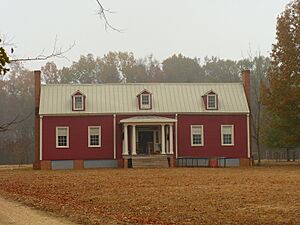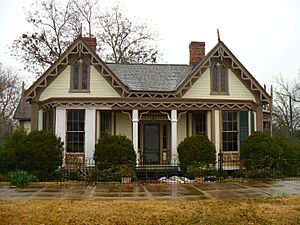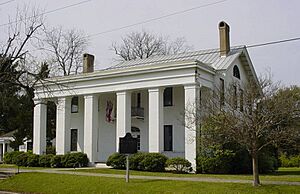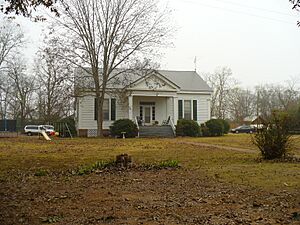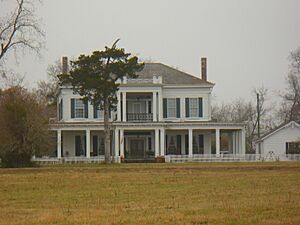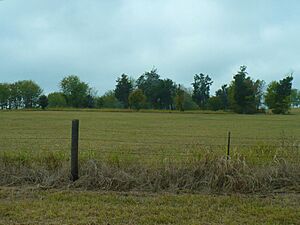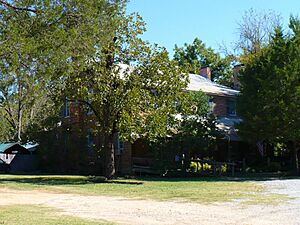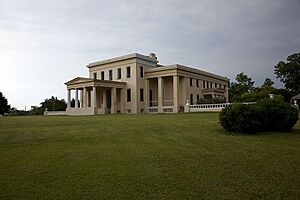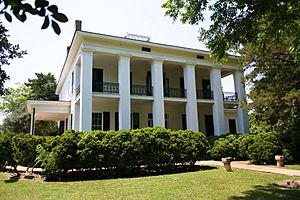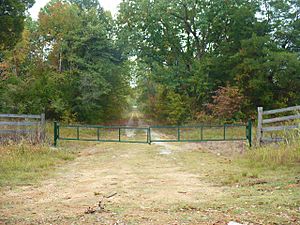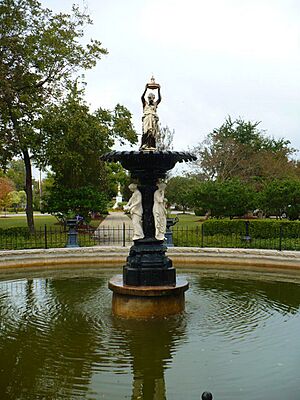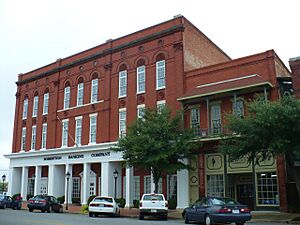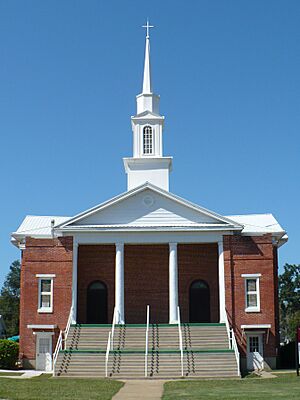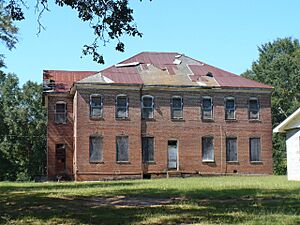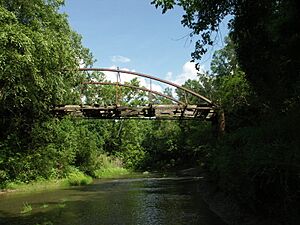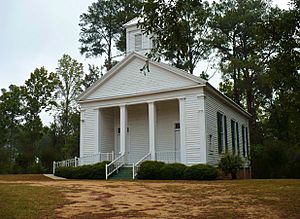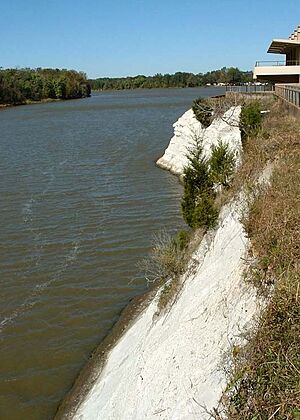National Register of Historic Places listings in Marengo County, Alabama facts for kids
Welcome to Marengo County, Alabama! This area is full of amazing old buildings and places that tell stories from the past. Many of these special spots are listed on the National Register of Historic Places. This is like a special list kept by the United States government to protect important historical sites.
In Marengo County, there are 28 places on this list. One of them is even a National Historic Landmark, which means it's super important to the whole country! Let's explore some of these cool historic sites.
Discovering Marengo County's Historic Gems
Marengo County is home to many buildings and areas that show us what life was like long ago. These places are protected so future generations can learn from them.
Grand Old Homes and Plantations
Many of Marengo County's historic listings are beautiful old homes and plantations. These buildings often show off popular architectural styles from the 1800s.
Allen Grove: A Greek Revival Beauty
Allen Grove is a historic area near Old Spring Hill. It includes a main house built around 1857. This house is a great example of the Greek Revival style, which was popular in the South. Imagine a grand house with tall columns, looking a bit like an ancient Greek temple! It was added to the list in 1994.
Altwood: A Touch of Virginia
Near Faunsdale, you'll find Altwood. This plantation house was built way back in 1836. It has a unique style that reminds people of homes found in the Tidewater Virginia area. It joined the National Register in 1993.
Ashe Cottage: A Remodeled Town House
In Demopolis, Ashe Cottage stands out. It was first built as a town house in 1832. Later, in 1858, it got a cool makeover in the Carpenter Gothic style. This style often features fancy wooden trim that looks like lace. It was listed in 1978.
Bluff Hall: A Mansion's Transformation
Also in Demopolis is Bluff Hall. This large house, or mansion, was built in 1832 in the Federal style. It was built for Francis Strother Lyon and his wife. In the 1840s, it was updated to the Greek Revival style, showing how tastes changed over time. It became a historic listing in 1970.
Cedar Crest: Another Greek Revival Gem
Cedar Crest, located near Faunsdale, is another beautiful Greek Revival style plantation house. It was built in 1850 for Kimbrough C. Dubose. This house was added to the list in 1993.
Cedar Grove Plantation: Art and Architecture
Cedar Grove Plantation, also near Faunsdale, is a large Greek Revival house from 1848. It's known for its connection to Nicola Marschall, a famous artist. This historic district was listed in 1993.
Cedar Haven: A Site of History
Sadly, the Greek Revival style plantation house known as Cedar Haven was built in 1850 but was later destroyed. However, the site itself is still important and remains on the National Register. It was listed in 1993.
Cuba Plantation: A Family Legacy
Cuba Plantation, near Faunsdale, has a long history. It was started by Andrew Pickens Calhoun, whose father was the famous John C. Calhoun. The plantation was sold in 1863 and has stayed in the same family ever since. It became a historic district in 1993.
Faunsdale Plantation: Greek Revival and Slave Quarters
Faunsdale Plantation is a historic district with a main house built in 1844 in the Greek Revival style. It also includes several slave quarters built in the Carpenter Gothic style. This site helps us understand different aspects of life in the past. It was listed in 1993.
Foscue-Whitfield House: An Old Brick Home
The Foscue-Whitfield House is a Federal style brick house built in 1840 for Augustus Foscue. It's located west of Demopolis and was added to the National Register in 1974.
Gaineswood: A National Treasure
Gaineswood in Demopolis is a very special place. It's a National Historic Landmark! Built by Nathan Bryan Whitfield between 1843 and 1860, this plantation house is considered one of the most amazing examples of Greek Revival architecture in Alabama. It's truly a masterpiece of design from that time. It was listed in 1972.
Lyon-Lamar House: Another Demopolis Mansion
The Lyon-Lamar House in Demopolis is a Greek Revival style mansion finished in 1853. It was built by George Gaines Lyon and his wife. This grand home was added to the list in 1974.
William Poole House: A Plantation Home
Near Dayton, the William Poole House is a Greek Revival style plantation house built in 1848. It was listed as a historic district in 1994.
Roseland Plantation: A Site with Remaining Outbuildings
Roseland Plantation near Faunsdale was once home to a Greek Revival style house built in 1850. While the main house is gone, some of the other buildings on the site still remain. It was listed in 1994.
Important Public Buildings and Districts
Marengo County also has historic public spaces and buildings that were important to the community.
Confederate Park: Demopolis Town Square
Confederate Park is the main town square of Demopolis. It was created in 1819 and covers a whole city block. It's one of the oldest public squares known in Alabama, a place where people have gathered for over 200 years! It was listed in 1975.
Demopolis Historic District: A Whole Area of History
The Demopolis Historic District covers a large part of the city. It includes many buildings that show the history and growth of Demopolis. This district was added to the National Register in 1979.
Demopolis Public School: A Grand School Building
The Demopolis Public School building is a beautiful example of Beaux-Arts style. This grand school was completed in 1914. It served as a public school for many years and was listed in 1983.
Old Courthouse: Linden's Historic Center
In Linden, you can find the Old Courthouse. This Greek Revival style building was finished in 1850 and was the third courthouse for Marengo County. It's a key part of the county's legal history and was listed in 1974.
Thomaston Central Historic District: A Town's History
The Thomaston Central Historic District covers a big part of the town of Thomaston. It shows off many buildings from the early 1900s. This district helps preserve the unique look and feel of the town. It was listed in 2000.
Thomaston Colored Institute: A School for Learning
The Thomaston Colored Institute was completed in 1910. It was built by the West Alabama Primitive Baptist Association to be a school for African Americans. This building represents an important part of educational history in the area. It was listed in 2000.
U.S. Post Office: Demopolis's Mail Hub
The U.S. Post Office in Demopolis is a Neoclassical style building. It was built in 1914 and has served as the city's post office for over a century. It was added to the list in 1984.
Unique Historical Sites
Not all historic listings are buildings. Some are natural features or bridges that played a role in history.
Glover Mausoleum: A Family Tomb
The Glover Mausoleum is an amazing Greek Revival style tomb in Riverside Cemetery in Demopolis. It was finished in 1845 by Mary Anne Glover for her husband, Allen Glover. It's a beautiful and important example of funerary architecture. It was listed in 1974.
Half-Chance Bridge: An Old Iron Bridge
The Half-Chance Bridge is an old iron bridge that crosses the Chickasaw Bogue Creek. It was built in 1880 by the King Iron Bridge Manufacturing Company. This bridge is a cool example of engineering from that time. It was listed in 1972.
Jefferson Historic District: A Village's Past
The Jefferson Historic District includes thirteen Greek Revival buildings in the village of Jefferson. These buildings show what the area was like before the Civil War, when plantations were very common. It was listed in 1976.
White Bluff: A Natural Landmark
White Bluff is a historic natural cliff above the Tombigbee River in Demopolis. French explorers in the 1700s called it "Ecor Blanc," meaning "White Bluff." It's a beautiful natural landmark with a long history. It was listed in 1970.
Images for kids




